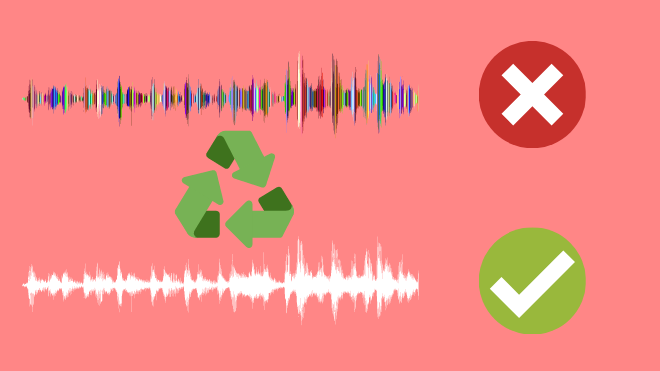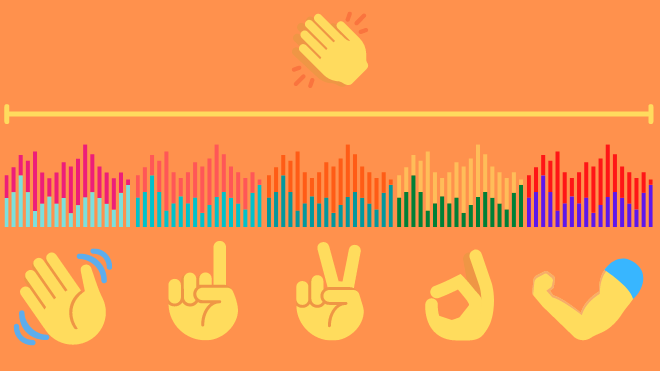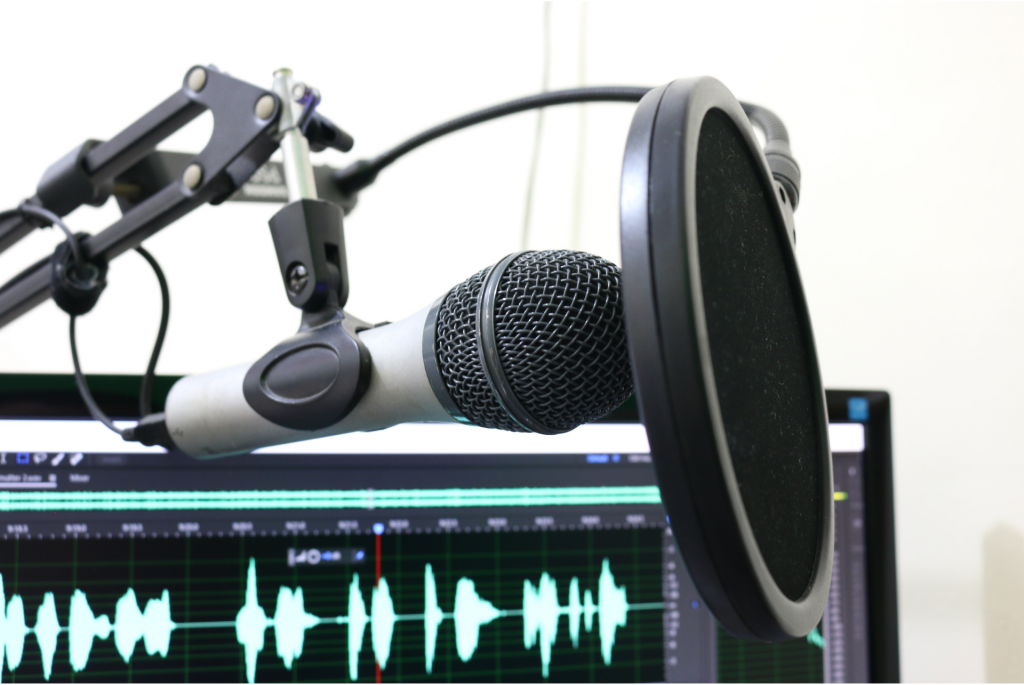Are you trying to build a career as a voice actor? The most important thing you can have to land gigs is a killer voice over demo reel that showcases your talent.
The good news is you can easily make a professional voice over demo right from the comfort of your own home.
Voice acting is a great way to make extra money if speaking well is one of your talents.
Often, voice work can be done from home, making it easy and convenient to fit into your busy schedule. You can even take great voice acting courses and public speaking classes from home to get the skills you need to earn.
You can do animations, voice overs for commercials, or even record audiobooks.
If you’ve ever thought about a voice acting career, you’ll need a good voice demo reel to get started.
Let’s explore what exactly that entails.
What is a Voice Over Demo?
Think of a voice over demo as your portfolio. With a typical job, especially a creative one, potential employers want to see examples of your work to get an idea of what you’d be like as an employee.
When it comes to voice acting, potential clients want to hear a showcase of your best work before deciding to give you the job.
In a voice demo, you’ll want to choose pieces that best represent your unique talents and the types of voiceover work that you’re looking to get hired for.
There are lots of genres to consider when pursuing a voice acting career, including:
- Audiobooks
- Animation
- Business/commercial
- Documentaries
- Guided meditations
- Self-help
- E-learning
- Podcasts
- Movie trailers
The unique qualities of your voice can help you determine which of these genres are the best fit for you.
Why Do You Need a Voice Over Demo?
Like most performing jobs, the competition in voiceover work can be fierce.
If you want to land jobs with the best clients, you need something that will make you stand out as a voice actor from the crowd.
This is where your voice demo reel comes in.

Clients typically have a specific type of voice in mind when looking for someone to do their voice acting. This makes it especially important that your voice over demo accurately reflects the quality of your voice in a way that showcases what you’re best at.
According to Voices.com, clients typically decide whether they want to hire you in the first 5-10 seconds of your voice demo. Without a high-quality voice over demo reel, your chances of catching their attention in this short window are slim.
With no voice demo at all, clients will never take a chance on you.
How to Make a Voice Over Demo: 7 Steps
If you’ve never thought about making your own voiceover demo, you might feel daunted about taking on the process on your own. Getting a voice over demo reel made professionally can cost hundreds or even thousands of dollars!
Luckily, it’s actually pretty easy to make your own voice demo at home.
Our guide below will tell you the tactics successful voice over artists use to create a demo reel that gets results.
You may also want to check out this online course on Domestika that goes into even further detail about creating a high quality demo reel so you can propel your voice acting career to the next level.
 Demo Reel with Adobe Premiere: Create an Impactful Portfolio (Thomaz Bastos) | Domestika
Demo Reel with Adobe Premiere: Create an Impactful Portfolio (Thomaz Bastos) | Domestika
Learn how to showcase your skills while telling the story of your career in this online course that teaches you how to build an engaging, compelling demo reel that gets you noticed.
Check out this video for a behind-the-scenes peek at how a professional voice actor pulls together a commercial piece for one of his clients.
There are plenty of great options out there for software that you can use to record a voice over demo in your own home studio.
In this video, a professional voice actor gives great advice on using a software product called Audioblocks to record and edit your voice demos simply and easily. The software looks complicated, but with the expert tips in this tutorial, you’ll be a pro in no time!
Let’s break down the specific steps that you’ll need to take in order to create the perfect voice over demo.
Step #1: Plan
Should you have multiple voice over demos, or just one? What kinds of pieces should you perform? Are there demo scripts for voice acting you should use? How long should your voice demo be? How should your demo be hosted?
These are just a few of the questions that you should ask yourself before starting to record a voiceover demo.
Style and Selection
If you have a variety of styles that you intend to pursue, it may be a good idea to create multiple voice over demos that cater to these different styles.
If clients are going to make a choice about you in the first few seconds of your voice over demo, you want those first few seconds to be exactly what they’re looking for!
This is much easier to accomplish if you have different demos dedicated to different styles or genres.
In each style, choose pieces that reflect the potential jobs that you’ll be auditioning for.
If you want to record audiobooks, make a voice over demo reading a short prose piece.
If you want to do commercials, record sample commercials in your voice demo.
Make sure that your clients can imagine exactly how you’ll sound recording their script as their voice actor.

Although there are lots of websites that provide scripts for voiceover demos, such as Edge Studio. Some professional voice actors think that using these scripts can be a bad idea.
The problem is that tons of other aspiring voiceover actors will be using the same demo scripts, and you want your demo to stand out!
Plus, these scripts can be dated, which would make your demo seem outdated, too.
Instead, consider using scripts from jobs that you’ve auditioned for (as long as it is permissible according to the script owner) or other more unique pieces that you find in other places.
One option for tailoring your voice over demo to your client is to create a variety of short clips in different styles that are saved digitally. This way, you can choose the most relevant clips for each job and combine select pieces into a perfectly customized demo for each potential client. It’s much easier to revise and combine audio than it used to be, so this is certainly a feasible option.
Length

The length of your voice over demo can vary, but it’s good to plan for 60-90 seconds when selecting the pieces that you want to perform. This is long enough for the client to get a good idea of what your particular skills and talents are without bogging them down with too much to listen to. Try to choose numerous different pieces of about 15-20 seconds in length so that you can effectively combine them into the
perfect demo reel.
Hosting
It used to be common for a voice actor to send out CDs or even tapes of their audio samples. These days, online hosting is typically the most convenient way to go. This allows you to edit your voice over demo more easily for each client. It also makes it easier for you to send the demo and for the client to download and listen to it. When planning your demo, find a good place online where you can host your demo that is easily accessible to potential clients.
Step #2: Research
When recording voice over demos, the worst thing you can do is try to re-invent the wheel. You probably hear dozens of voice actors online, on TV, and on the radio every day. Now, all that you have to do is really start paying attention.

Find examples of the types of work that you want to do and listen to them closely. It’s best if you can find a particular actor whose sound resembles your own voice and do your best to mimic them.
What do the actors’ voices sound like? How do they deliver their lines? What kinds of background sound effects do they use?
By creating something that largely resembles the professional voiceover work that’s already out there, you’re more likely to land those commercial jobs that will get your name out there.
Most of these actors have their own websites where you can listen to their demo reels and voice over work. Once you find a few actors whose voices are similar to yours and who are doing the kind of work that you want to do, head over to their websites and start studying their voice over demos!
Below are a few examples of professional, high quality demo reels and voice over work to get you started on your research:
Kabir Singh
Evan Christiano
Joshua Alexander
Step #3: Practice
Just listening to voice over work from other pros isn’t going to be enough, even if you listen closely and meticulously take notes about their style and choices.
If you’re going to create a jaw-dropping demo, you need to practice using your own voice and getting used to your voice over microphone.
Regular, consistent practice is the only way to elevate your vocal abilities.
Take those pieces that you’ve been listening to and attempt to recreate them yourself using the same styles and inflections that the seasoned actors used. Keep repeating them over and over until you’re confident that you’ve absolutely nailed it!
Once you can mimic your samples, you’ll be ready to apply their strategies to your own carefully chosen scripts.
Make sure that you take the time to practice performing your chosen scripts exactly how you want them to sound on your voice over demo reel.
Use the same recording setup that you’ll use during your demo production to get the most accurate picture of your progress.

It can sometimes be hard to accurately hear your own voice, even if you have a pretty good ear.
For this reason, it can be helpful to record your practice sessions so you can play them back and judge how similar yours is to the example. This is an important part of the voice over demo production process.
If possible, working with a voice over actor coach can be a great option. They can help you learn how to use your voice in the same way that a music teacher would train someone to play their instrument.
If a voice over actor coach isn’t in your budget, talk to a family member or friend who has a good ear and ask them to listen to your practice tapes and offer advice.
There are also social media groups for aspiring voice actors where you can get great feedback and advice.
Step #4: Record
Now, it’s time to actually start making the recordings that you’ll use as part of your voice over demo.
You may have to record each of your samples multiple times to make sure that they sound crisp and professional, without any mistakes.
Be sure to perform in a quiet, distraction-free environment so that you can avoid having to edit too much out later.
Equipment
When recording your voiceover demo, you won’t want to use the voice recorder on your cell phone or a handheld recorder. The microphones built into smartphones and other cheap recorders aren’t going to give you the type of professional sound that clients are looking for in a commercial demo.

You don’t need to build an entire studio; however, there are a few pieces of equipment that you might want to consider investing in.
If you’re going to do voiceover work from home, this equipment will come in handy for creating the best products for your client, so you might as well invest in these pieces for recording your demo as well.
Some pieces that you might want to consider include the following:
- Microphone: The better the microphone, the higher quality your voice will sound in your recordings. The Blue Yeti is my personal top pick for a voice over mic.
- Headphones: Having a good set of studio headphones will allow you to easily play back your recordings so you can determine what changes need to be made. The Sennheiser HD280PRO is a great choice for headphones for your home studio.
- Microphone mount: If you’re physically handling your microphone while recording, your audio will sound uneven in the finished product and make editing far more difficult
- Shock mount: Even on a microphone stand, a high-quality microphone may pick up vibrations from your environment; a shock mount will prevent this and provide better sound quality
- Pop filters: Even if your speaking voice is on point, the microphone might pick up too much of certain sounds, such as sibilants and plosives; pop filters can prevent this issue and make editing easier
- Noise dampening equipment: Many pros that you see and hear online use heavy curtains or other acoustic treatments to block out background noise and make cleaner, crisper audio
Take a look at what other professionals use in their home studios before purchasing costly equipment. Quality is important, so look for brands that top voice actors have given their seal of approval before investing in something that might end up making or breaking your voiceover career.
Style
A perfectly affected transatlantic accent may have been all the rage a century ago, but these days, styles have changed.
Most clients are looking for a more natural delivery style that reflects the way that people actually talk.
Unless you’re hoping to perform animation, stick with your natural voice when making your voice over demo: just make it a little more polished than you sound when talking to your friends.

Your style should also reflect the type of script that you’re recording. An audiobook should be crisp and professional, whereas an animation can be a bit zanier. A guided meditation should be soft and gentle, while an advertisement can be more animated. Remember the lessons that you learned while researching other voice actors and apply them to your own recordings.
Step #5: Edit
Sending a raw audio file can make your voice over demo sound amateurish and not polished.
Think of it like sending an unedited manuscript to a publisher: the overall writing could be great, but the publisher will likely be too distracted by typos to notice your talent.
Editing is the key to making sure your vocal skills are put on display in the best possible light.
Software
When it comes time to edit your voice over demo, take some time to consider different software options. Different software will give you different tools to make your demo pop.
If you’ve never edited your own audio before, choose something with a simple user interface. It’s easy to get overwhelmed by all of the professional tools that are out there, so keep it simple to start and read reviews to see what other professionals are using.

You can also scour YouTube for tutorials that will help you learn how to use the software that you choose. For example, check out this tutorial that covers the basics of using just about any audio equalizer.
What to edit
There are a variety of different things to look out for when editing your audio. You’ll first want to take out any background noise that made its way into the final product. This includes any clicks or vibrations from the equipment and background, as well as your own breaths. Removing these sounds will make your finished audio cleaner and crisper.
You’ll also want to use your software’s equalizer to round out any plosives and sibilants that the pop filters didn’t catch. This will allow your voice over demo to capture the true sound of your voice more accurately, picking up each nuance without any distractions.

While it’s important to use editing to create high-quality audio, be careful not to over-produce your voice over demo.
You still want the clips in your voice reel to sound like you! An over-produced demo is a major turnoff for clients who need to hear how your voice actually sounds, not an auto-tuned version that sounds like a robot.
Music
Most voiceover demos contain more than just your voice.
Well-chosen background music and sound effects will give your demo a professional touch.
Background music can also cover up any small flaws that you were unable to eliminate during editing. There are a lot of websites where you can download royalty-free music that can be easily added to your demo.
Make sure that whatever music you choose contributes to the overall feel of your demo. You want the music to complement your voice, not overpower it.
If you’re recording a guided meditation, choose something light and pretty. If you’re doing a commercial for an exciting new product, choose something more upbeat and edgy.
Most audio software should have tools that allow you to easily layer your demo with music and sound effects. Take some time to learn how to use these tools so that the music blends seamlessly with your voice.
Step #6: Build
Whether you’re creating just one voice over demo or multiple, you’ll want to take time to put together the perfect 60-90 second reel to showcase your voice and capture your audience’s attention.
Think carefully about which clip to use first to really grab your listener.
If you’re only making one voice over demo, put your best piece at the beginning; then, mix in different sounds to really showcase your entire range so you create a great first impression. End on a strong note so that the last thing the client hears before making their decision is something that really sparkles.

If you plan on creating a variety of demos for different types of work, be careful not to make the reels too one-dimensional. Even if each demo is for a particular type of work, you don’t want each piece in the demo to sound exactly the same. Clients want actors who can do a variety of things with their voice, so be sure that each demo really showcases your range.
Hopefully, the client will keep you in mind the next time they’re looking to case an actor with your different styles.
Step #7: Refresh
Once you have a great voiceover demo reel to send off to clients, that doesn’t mean that your work is done!
Your voice over demo should be refreshed regularly as you take on new work.
Sending outdated clips from early in your career isn’t the best way to get more jobs.
Show clients how your craft has progressed by adding newer pieces to your voice reel. This is particularly important if your demo includes dates, pop culture references, or advertisements for products that may have changed or vanished.

You’ll also want your voice over demo reel to reflect changing trends and updates in equipment and editing software. This will show potential clients that you are a contemporary professional that they should want to hire.
Final Thoughts
Doing voiceovers and other voice acting is a great career option for many people, especially if you have a pleasant speaking voice.
You can often work from home and set your own hours as a voice actor, so you can easily schedule it around your full-time job to make extra cash.
Creating your first voice over demo reel can feel daunting, but if you follow the simple steps in this guide, you should have no problem creating a professional demo that will wow potential clients.
Now get out there and start recording!
In case of problems with voice recording (unwanted sounds and breathing), learn how to remove them!
Have a question about making your own voice over demo? Leave a comment and we’ll help you out!
- Elevating Your Virtual Presence: Why EMEET’s SmartCam S800 Stands Out in Modern Communication - 06/04/2025
- US Teachers Will Spend $3.35 Billion of Their Own Money on Classroom Expenses in 2025-25 School Year - 06/04/2025
- Report: Leveraging AI Tools Could Help US Teachers Avoid $43.4 Billion of Unpaid Overtime Work - 06/04/2025


